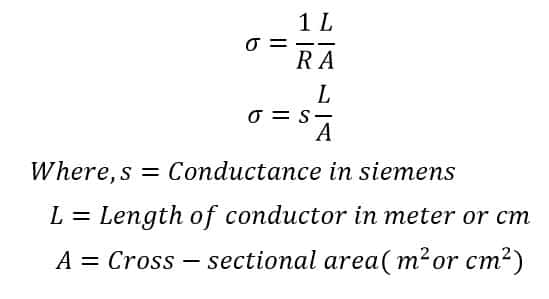What is Electrical Conductivity?
Electrical conductivity is the property of the material that allows electric current to pass through it. In other words, electrical conductivity is the measure of electrical current passing through the material when the potential gradient is unity.
Thus, electric conductivity measures the ability of a conductor to conduct electricity.
In electricity, it is one of the important factors that designers consider during the designing of the electrical system. Copper and aluminum are the most suitable conductors because their conductivity is very high. The higher conductivity indicates the passing of more electrons through the materials without much impediment.
The higher conductivity material has lower resistance and causes less heat loss(I2R) in the conductor. For example. the printed circuit board has complex electric circuitry, and the path conductivity must be very high to avoid the hindrance of the flow of electric current. For this application, galvanized copper is the most suitable.
Effect of temperature on Electrical Conductivity
The electrical conductivity of the specimen of the material depends upon the atomic configuration, length & cross-sectional area of the materials. These parameters remain the same after designing the resistance, therefore, they do not change the conductivity. However, the conductivity lowers with an increase in temperature. Why is it so?
We know, the current flow in the electric circuit is nothing but the flow of electrons. Higher numbers of electrons passing through the material per second mean the material has higher conductivity. The temperature rise cause collisions between electron to electron and collision with the atom. As a result, the flow of the electrons through the material becomes sluggish & which causes a decrease in the electrical conductivity of the material.
Thus, we can conclude that the conductor has higher conductivity at low temperatures. You would have heard about superconductivity. What is it? Superconductivity is the property of the substance that makes it capable to conduct electricity without impedance, which means resistance is zero. This is possible if the substance temperature is colder than a critical temperature.
Symbol of Conductivity
The symbol of electrical conductivity is symbolized with a Greek Letter σ (Signa). The electrical conductivity is inversely proportional to the electrical resistivity(ρ).
The relation between conductivity and resistivity is given below.
σ = 1/ρ
Electrical Conductivity Formula
The resistance of the conductor depends on the conductivity of the material, cross-sectional area, and length of the substance. On the basis of these parameters, we can derive the equation of electrical conductance.
Derivation of electrical conductivity equation/ Formula
R ∝ 1/σ ——-(1) R ∝ L ——-(2) R ∝ 1/ A ——-(3)
Thus,
R = 1/σ (L/A) ——-(4)
σ = 1/R x (L/A) ——-(5)
σ = S x (L/A) ——-(5) [ Here S is conductance & S = 1/R ]

Reciprocal of resistance(R) is the conductance(S) & reciprocal of Ohm(Ω) is mho(Ω−1 or ℧ )
Here, R is resistance in Ohm(Ω)
A = Cross-sectional area in cm2 or m2
L = Length of conductor in centimeters(cm) or meters(m)
σ= Conductivity of the material(Ω-cm) or (Ω-m)
S = Electrical conductance
The electrical resistivity of the material is directly proportional to the cross-sectional area and inversely proportional to the length.
Unit of Conductivity
The formula of conductivity
σ = S x (L/A)
From above the unit of conductivity is
σ = S x (L/A)
σ ∝ mho x Cm/Cm2) ∝ siemens-cm-1 ∝ Siemens/cm
The unit of electrical conductivity is siemens/cm and siemens/meter.
Good and Poor Electrical Conductivity Materials
| Good Electrical conductivity materials | Poor Electrical conductivity materials |
| Silver | Rubber |
| Copper | Glass |
| Gold | Plastic |
| Aluminum | Dry wood |
| Zinc | Diamond |
| Nickel | Air |
| Brass |
Read Next: